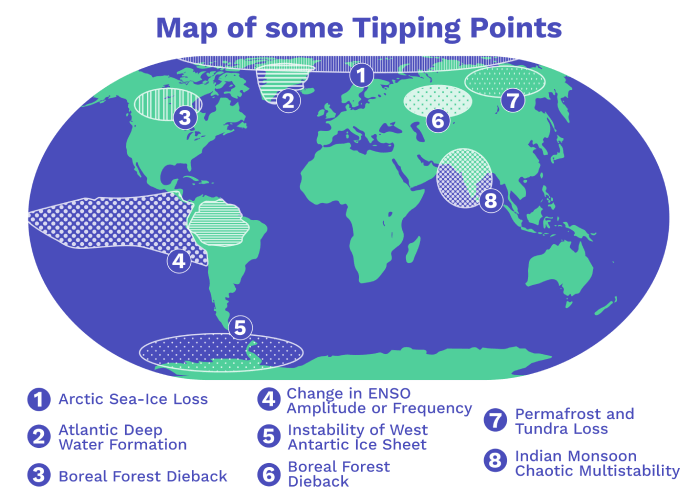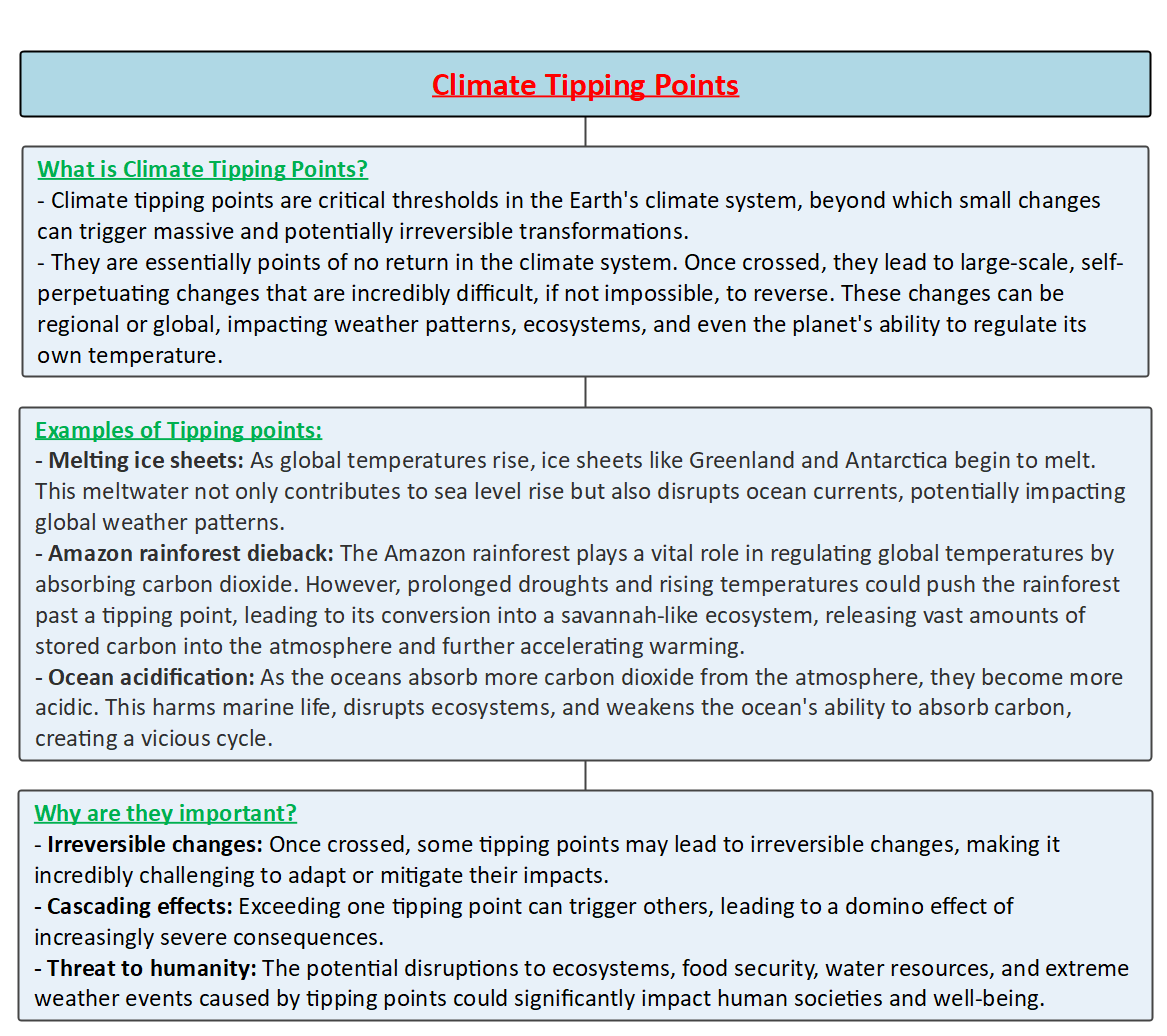Description

Copyright infringement not intended
Picture Courtesy: https://climatescience.org/advanced-climate-climate-tipping-points
Context: Climate tipping points are critical thresholds in the Earth's climate system, beyond which natural systems can undergo irreversible and disastrous changes. These changes can lead to more warming and have cascading effects on the planet.
Climate Tipping Points
- Climate tipping points are critical thresholds in the Earth's climate system. When crossed, they can lead to abrupt and irreversible changes, significantly impacting the environment and human societies.
- These points represent a sort of "point of no return," where the climate system undergoes rapid and often unpredictable shifts.
Key Characteristics
- Irreversibility: Once a tipping point is crossed, the changes triggered are typically irreversible, making it challenging to revert to the previous state.
- Abrupt Changes: Tipping points often result in sudden and substantial alterations rather than gradual shifts, posing challenges for adaptation.
Examples of Climate Tipping Points
- Arctic Sea Ice Melting: The Arctic region is particularly vulnerable. As ice melts, it reduces the reflective surface, leading to more heat absorption and accelerating further ice melt in a self-reinforcing loop.
- Amazon Rainforest Degradation: Deforestation and climate change could push the Amazon rainforest to a tipping point where it transitions from a lush ecosystem to a drier savannah, impacting biodiversity and climate regulation.
- Melting of Greenland Ice Sheet: The melting of the Greenland ice sheet can contribute to sea-level rise, affecting coastal areas and low-lying islands globally.
Consequences of Tipping Points
- Sea-Level Rise: Tipping points can contribute to the melting of polar ice caps and glaciers, resulting in rising sea levels, and threatening coastal communities.
- Extreme Weather Events: Changes in climate patterns may lead to an increase in the frequency and intensity of extreme weather events, such as hurricanes, droughts, and heat waves.
- Biodiversity Loss: Tipping points can disrupt ecosystems, leading to the loss of biodiversity as species struggle to adapt or face extinction.

Factors Contributing to Tipping Points
- Positive Feedback Loops: Amplifying feedback loops, where the consequences of a change reinforce and intensify the initial shift, can push the system towards a tipping point.
- Human Activities: Anthropogenic factors, such as deforestation, greenhouse gas emissions, and land-use changes, significantly contribute to pushing various components of the climate system towards tipping points.
Addressing Tipping Points
- Mitigation Strategies: Efforts to reduce greenhouse gas emissions and protect critical ecosystems can help prevent the crossing of tipping points.
- Adaptation Measures: Communities and nations need to develop adaptive strategies to cope with the impacts of tipping points that may already be underway.
Challenges and Uncertainties
- Complex Interactions: The interconnectedness of different climate components makes predicting and understanding tipping points challenging.
- Global Cooperation: Addressing tipping points requires international collaboration to tackle global environmental issues collectively.
Way Forward
Reduce Greenhouse Gas Emissions
- Shift from fossil fuels to renewable energy sources such as solar, wind, and hydroelectric power.
- Improve energy efficiency in industries, transportation, and buildings to reduce overall emissions.
- Encourage sustainable practices in agriculture, deforestation, and land use to minimize emissions.
Invest in Adaptation and Resilience
- Develop and implement resilient infrastructure to withstand the impacts of climate change, such as rising sea levels and extreme weather events.
- Support local communities in developing adaptive strategies suited to their specific needs and vulnerabilities.
- Invest in the restoration and conservation of ecosystems that act as natural buffers against climate impacts.
Support Research and Monitoring
- Increase funding for research on climate tipping points to enhance our understanding of their triggers, dynamics, and potential impacts.
- Develop and implement early warning systems to monitor changes in critical climate components and provide timely alerts.
- Encourage collaboration between scientists, policymakers, and communities to bridge knowledge gaps and ensure comprehensive strategies.
International Cooperation
- Support and strengthen international agreements, such as the Paris Agreement, to foster collective action and commitment to emissions reduction targets.
- Facilitate the transfer of sustainable technologies from developed to developing nations to accelerate global decarbonization efforts.
Education and Advocacy
- Promote awareness of climate change and the importance of individual and collective actions.
- Engage in advocacy efforts to push for policies that prioritize sustainability, emissions reduction, and climate resilience.
.jpg)
Community Engagement
- Involve local communities in decision-making processes related to climate action to ensure their perspectives and needs are considered.
- Provide communities with the knowledge and tools to implement sustainable practices and adapt to changing conditions.
Policy and Regulation
- Implement and enforce policies that promote sustainable practices, penalize emissions, and protect vulnerable ecosystems.
- Explore and implement carbon pricing mechanisms to incentivize businesses and individuals to reduce their carbon footprint.
Innovation and Technology
- Invest in the development of innovative technologies that can help in carbon capture, sustainable agriculture, and climate-resilient solutions.
- Support and promote green businesses and startups focused on sustainable practices.

Conclusion
- Climate tipping points demand urgent attention and action. Understanding their dynamics and consequences is crucial for formulating effective strategies to mitigate their impacts and ensure a more resilient and sustainable future for our planet.
|
PRACTICE QUESTION
Q. Which of the following is NOT a potential strategy to mitigate the risk of climate tipping points?
A) Rapidly reducing greenhouse gas emissions to achieve net-zero emissions
B) Developing technologies to capture and store atmospheric carbon dioxide
C) Investing in adaptation measures to prepare for the impacts of climate change
D) Geoengineering interventions to manipulate the Earth's climate system
Answer: D
Explanation: While all the options listed have potential roles, geoengineering (option D) is a highly controversial and risky approach with uncertain consequences. It's not considered a mainstream mitigation strategy due to its potential for unintended side effects.
|
|
Q. How will the impacts of climate tipping points be distributed unevenly across different regions, populations, and socioeconomic groups? What ethical considerations should guide our response, ensuring justice and equity in the face of these potential thresholds?
Answer Structure:
●Define what climate tipping points are and why they are important for understanding the impacts of climate change.
●Provide some examples of climate tipping points that have been identified or projected by scientific research, such as melting ice sheets, permafrost thawing, or forest dieback.
●Explain how these tipping points can have uneven effects on different regions, populations, and socioeconomic groups, depending on their exposure, vulnerability, and adaptive capacity.
●Discuss the ethical implications of these uneven impacts, such as the responsibility of high-emitting countries to mitigate and support low-emitting countries, the rights of indigenous peoples and marginalized communities to participate in decision-making, and the need for intergenerational justice and equity.
●Conclude by summarizing the main points and suggesting some possible actions or policies that could address the challenge of climate tipping points fairly and effectively.
|

















